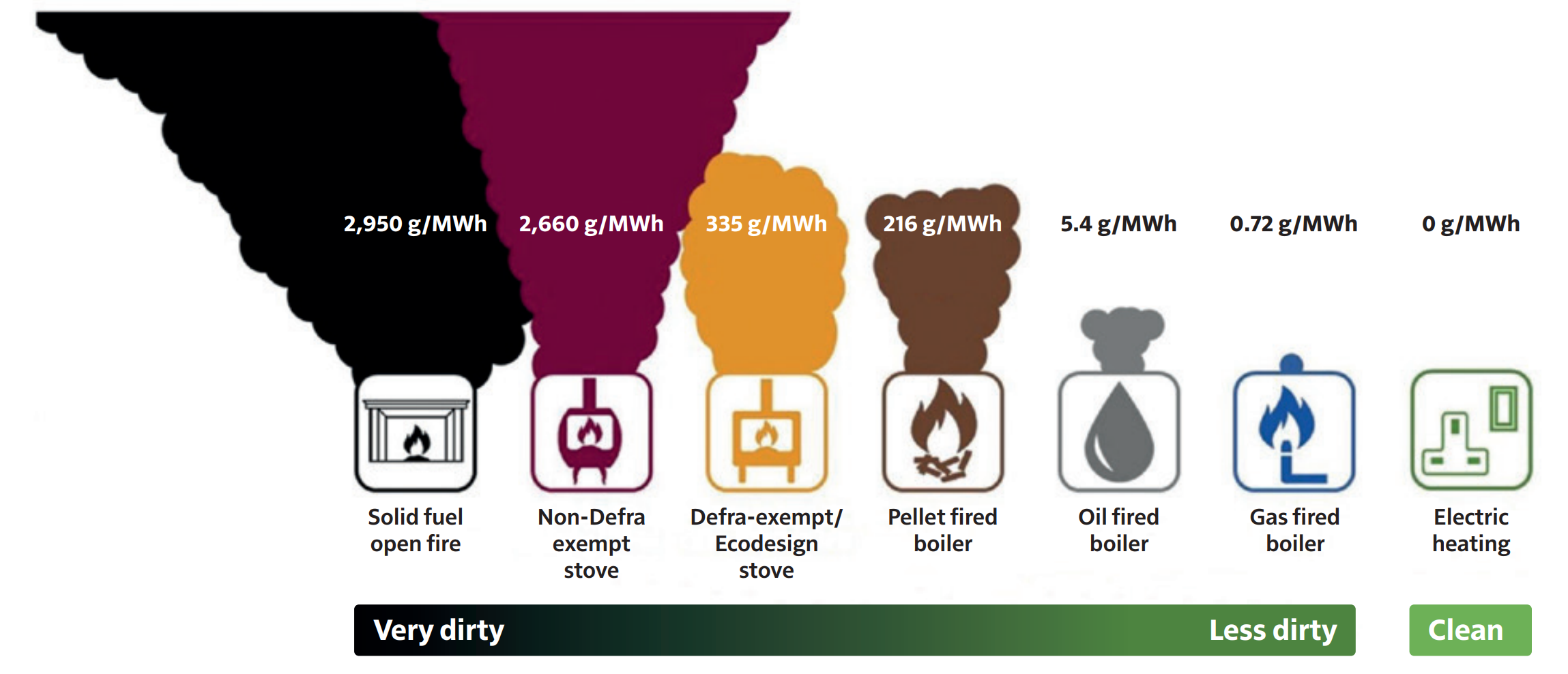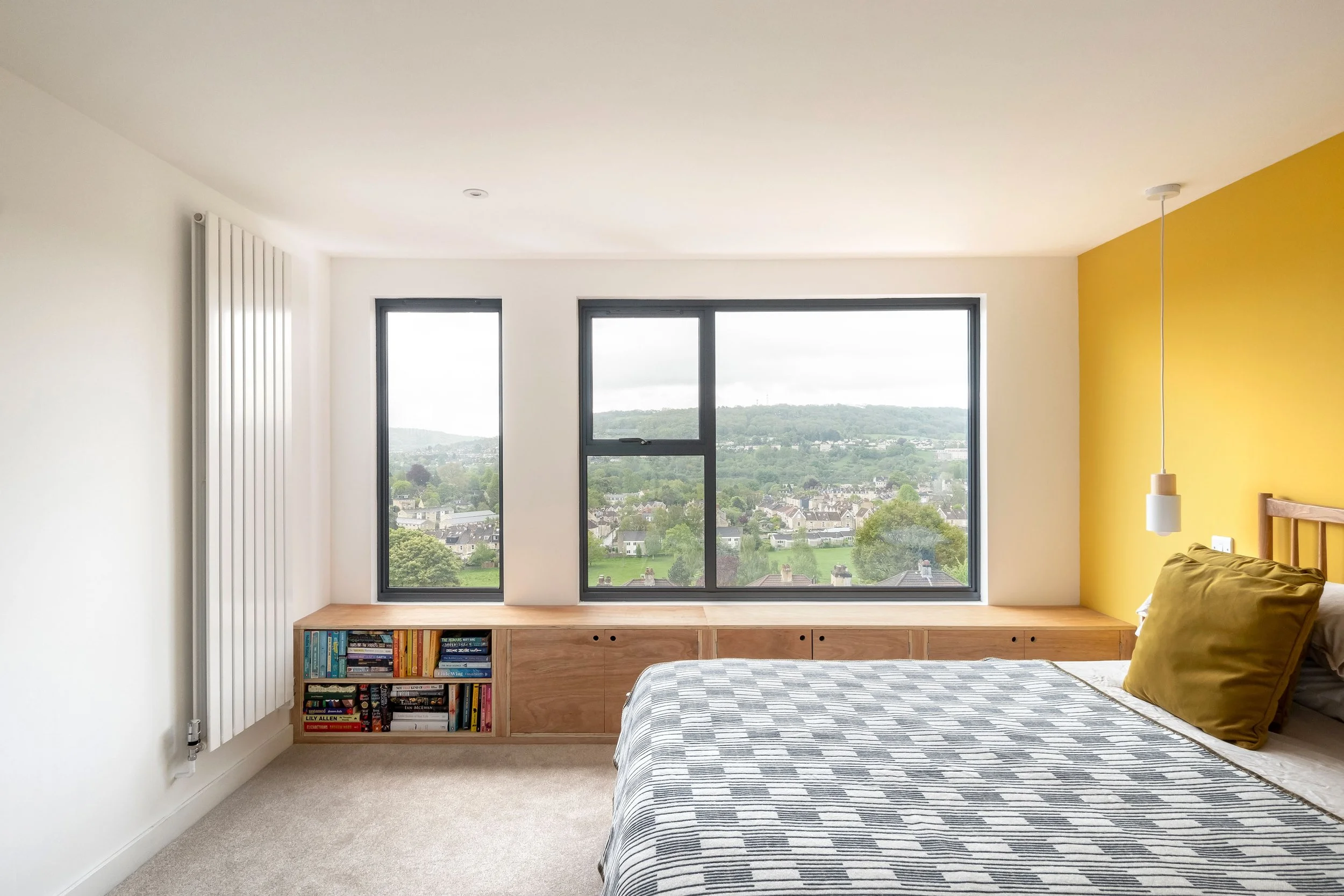Note 5. No Smoke without Fire
We say no to projects with wood burning stoves* and support you with alternatives.
*with some exceptions.
By Cam Dempster
We believe that as a species we need to limit combustion immediately, by means of burning trees in the form of fossil fuels or solid wood, including inside our homes.
We will assist with regulations and specification of wood burning stoves, and only include them on our drawings when:
they are existing
you have no other technically viable heat source.
In this post we explore the appeal of wood burning stoves, suggest some positive mindsets, and put forward practical substitutes.
Let’s start with consumerism
The wood-burning stove has been a trend, a marker of social class, and an aspirational socioeconomic status symbol. Culturally they exude a sense of modest affluence, carefully curated to reflect an image of cultivated taste yet remain firmly rooted in the predictable and conventional trappings of the middle class.
We want to encourage conversations around the pressures on us as individuals in a consumer society.
“A house is just a place to keep your stuff while you go out and get more stuff.”
George Carlin
Does a wood burning stove make a house a home, and more than a vessel for our overconsumption?
Ask why you want a wood burning stove?
The psychology of fire is a multifaceted and deeply ingrained aspect of human experience. We are fascinated by it: for survival, technological advancement, social gathering, comfort, power, spirituality and not least the hypnotic effect of staring into a fire. Mastery of fire potentially provided an evolutionary advantage and cognitive development that further deepens our connection, and the use of fire has long been considered a defining property of our intelligence (Scott, 2018). We’re proud of it.
Our early experience with fire is for light and warmth at night, and to frighten off predatory animals (Scott, 2018). Maybe this instinct to provide for and protect our families has led to a deep-seated psychological requirement for a fire in our homes. It fundamentally makes us feel safe, so we can relax and put our feet up in the evening with our children tucked up in bed.
Air quality
Unbeknownst to most wood burning stoves are leaving our homes less healthy. We’re paying the price for our dependence on fire, and not just on a global scale.
Air pollution, external and internal, contribute negatively to health, contributing to multiple conditions across generations such as low birth weight, asthma, reduced lung function in growing children, heart disease, lung cancer, diabetes, heart attack, failure and stroke (Public Health England, 2018). With over 80% of a typical adult day spent inside, with the rise of working from home, internal air quality is critical to consider when designing your home.
Indoor air pollution consists of nitrogen oxides (NOx), particulate matter (PM) and Carbon Monoxide (CO). All of which are produced from combustion processes in solid fuel burning stoves, more so in appliances that aren’t well maintained or burning ill-suited materials such as treated woods of wood that hadn’t been dried.
Chief Medical Officers Annual Report 2022
The image above provides clear diagrammatic explanation on the difference between different types of internal combustion available and their effect on air quality. It is worth noting that the age of the appliance, the type and age of the wood burned, and its maintenance substantially change the pollution emissions. It’s clear to view that open fires and wood burning stoves are the largest contributor to pollutants inside your home by a large volume.
Simultaneously the increase in incidence of wood burners in urban areas have been shown to worsen local air quality, especially in winter months. From 2012 to 2022 the rise in particulate emissions of PM2.5 and PM10, from burning solid fuel such as wood, has increased 19% (Horton, 20224). The name of the particulate matter (e.g. PM2.5) states the size of the particulate matter – PM2.5 pertaining to particles less than 2.5micrometers in diameter. These particles are damaging to health; with estimations of early death of more than 400,000 people across Europe each year (CMO, 2022).
To tackle indoor and outdoor air pollution it’s clear that strategies and being open-minded towards alternative approaches is important.
Make a house a home, without a wood burning stove
“If there is a pile of manure in a space, do not try to remove the odour by ventilation. Remove the pile of manure.”
Max von Pettenkofer, 1858
Dilution is not the solution to indoor pollution, source control is. In basic terms, to improve air quality, remove the source of pollutants then ventilate to protect from uncontrolled sources (e.g. Carbon Dioxide build up from breathing).
There are minimum requirements for a house: heat, light, protection. These are met by meeting minimum requirements in the Building Regulations for insulation, central heating system (gas until 2025 for new build or 2035 for existing homes, or renewable), a mains electricity supply, and modern security such as locks and alarms.
Therefore, except where a building is off grid, a wood burning stove is only providing ambience and filling a psychological need.
We are intrinsically drawn to fire to connect and relax, and wood burning stoves can ‘make a home’, but there are alternatives that don’t cost our health or the air that we breathe.
Firstly, prioritising changes to our habits and buildings in the first instance, to promote social connection and dopamine:
Putting down our phones and tablets.
Sitting across from each other at the dinner table.
Designing broken plan spaces with social connection, and spaces that bring us joy.
Creating other focal points to make our houses a home, for example a special view, use of light, choice of materials, or art.
Then considering alternatives:
Electric Fires
If you still want the aesthetic of a ‘fire’ as a focal point, an electric fire aligns better with a sustainable future. As the only potentially renewable option, we’ve sourced some great examples:
British Fires
UK company based in Dorset, manufacturing simple well made electric fires and stoves, avalible with real logs from the New Forest.
Recommended showroom:
EvonicFires
British built electric fires with natural or coloured flame effects, and app or remote control. More expensive than Bristish Fires but come with more features. Double sided fires, stoves, and holographic technology avaliable.
Recommended showroom:
Garden Fire Pit
If you REALLY want to feel the burn, then consider a chimenea or fire pit in your garden.
Whilst still emitting pollutants by burning wood, you don’t impact your internal air quality, and still have the hypnotic effect of fire and enjoyment of poking sticks or cooking marshmallows on an open flame.
As it is outside you are likely to use it less, which is a good thing!
Bioethanol Fires
Bioethanol fires are easily available and are straightforward to install not requiring a flue. However, there are many concerns about them as a mainly decorative appliance, including:
Rapid increase in production of biofuel has led to concerns over deforestation, workers’ rights, and land grabs in countries such as the USA, Brazil and Malaysia. It is very difficult to ensure that the biofuel you buy comes from a truly sustainable and ethical source. (Nuffield Council on Bioethics, 2011)
Many fire and rescue services have concerns over safety following incidents of burns, and spilled fuel which is highly flammable.
There is currently no specific legislation or standard in the UK in relation to bio ethanol fires, and no CE markings.
The UK building regulations do not cover their use, unlike gas appliances, including the provision of adequate ventilation to avoid build-up of gases, safe fuel storage, and minimum distances from combustible materials (e.g. curtains). Currently manufacturer’s advice is the only guidance.
For these reasons we don’t recommend them.
Gas Fires
Even a very efficient gas fire is still combusting inside your home and burning fossil fuel. As with gas boilers the technology is being phased out.
We believe that human beings need to move on from a million years of burning trees, disconnect psychologically from fire, embrace alternative energy sources, and build our culture around them.
We recognise this is easier said than done but we hope to support you with making small decisions in your home.
Further reading
Home Building magazine Link
George Monbiot (British journalist, author, and environmental and political activist) has published many articles in The Guardian regarding the argument against wood burning stoves. Link
References
Chief Medical Officers Annual Report, 2022, Air Pollution [pdf] [Accessed 5th July 2024] Available from: https://assets.publishing.service.gov.uk/government/uploads/system/uploads/attachment_data/file/1124738/chief-medical-officers-annual-report-air-pollution-dec-2022.pdf
European Environment Agency, 2019. EMEP/EEA air pollutant emission inventory guidebook 2019. [Accessed 5th July 2024]. Available from: https://www.eea.europa.eu/publications/emep-eea-guidebook-2019
Horton, H., 2024. Wood-burning stoves help undermine fall in particulate pollution from UK Roads [Article] [Accessed 9th July 2024] Available from: https://www.theguardian.com/environment/2024/feb/14/wood-burning-stoves-cancel-out-fall-particulate-pollution-uk-roads
Nuffield Council on Bioethics, 2011. Biofuels: ethical issues. A guide to the report [pdf] [Accessed 10th July 2024]. Available from: https://www.nuffieldbioethics.org/assets/pdfs/Biofuels_ethical_issues_A5_Guide.pdf
Public Health England, 2018. Health matters: Air pollution. London: Public Health England; 2018. [Accessed 5th July 2024]. Available from: https://www.gov.uk/government/publications/health-matters-air-pollution/health-matters-air-pollution
Scott, Andrew, 2018. When Did Humans Discover Fire? The Answer Depends on What You Mean By ‘Discover’ [article] [Accessed 10th July 2024]. Available from: https://time.com/5295907/discover-fire/
Do we sound like a good fit for your project?











